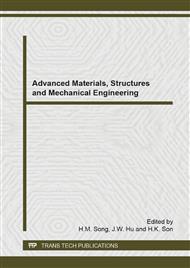p.641
p.645
p.651
p.656
p.661
p.668
p.672
p.677
p.683
A Fundamental Study on the Processing of Heavy Metals Contained in Underground Water by Composite Modulation Electromagnetic Field Processing
Abstract:
The present study is aimed at deriving study factors appropriate for removal of heavy metals in a region with combined contamination of non-biodegradable organics or heavy metal ions in soil or underground water contamination or a region with underground water contamination using a composite alternating current electromagnetic field with combined modulation of an electric and a magnetic field. In addition, it is directed at deriving fundamental experiment, design factors that can be utilized in removing organic contaminants or metal-organic complexes having polarity of an electric charge. The continuous-type apparatus for fusion process in a composite alternating current electric field employed in the present study was designed to process a maximum of 260 L. Each configuration is provided with electrolytic decomposition apparatus, Magnetic Equipment, Power supply and Electrode plates with an adjustable distance between electrodes. By measuring oxidation and reduction processes of ions appearing in chemical reaction processes, electric potentials produced by injection of a negative reactivity electrode into an aqueous solution in a reversible redox equilibrium condition were measured.
Info:
Periodical:
Pages:
661-667
Citation:
Online since:
September 2014
Authors:
Keywords:
Price:
Сopyright:
© 2014 Trans Tech Publications Ltd. All Rights Reserved
Share:
Citation:


